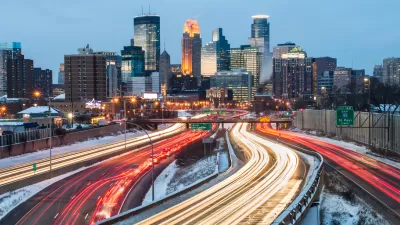Nicolai Ouroussof uses four cities--New Orleans, Los Angeles, The Bronx, and Buffalo--as case studies on how America's urban areas, long neglected, can once again be great.
"Even China, a country where centralized planning often looks like a grotesque parody of American postwar development, is beginning to move toward more sustainable, dense urban models. The government recently announced an $88 billion plan for freight and passenger trains that will link every major urban center along the country's coast, from Beijing to the Pearl River Delta. And it is building miles of subway lines in booming cities like Shenzhen and Guangzhou.
The problem in America is not a lack of ideas. It is a tendency to equate any large-scale government construction project, no matter how thoughtful, with the most brutal urban renewal tactics of the 1950s. One result has been that pioneering projects that skillfully blend basic infrastructure with broader urban needs like housing and park space are usually killed in their infancy. Another is that we now have an archaic and grotesquely wasteful federal system in which upkeep for roads, subways, housing, public parkland and our water supply are all handled separately.
With money now available to invest again in such basic needs, I'd like to look at four cities representing a range of urban challenges and some of the plans available to address them. Though none of the plans are ideal as they stand today (and some of them represent only the germ of an idea), evaluated and addressed together as part of a coordinated effort, they could begin to form a blueprint for making our cities more efficient, sustainable and livable."
FULL STORY: Reinventing America’s Cities: The Time Is Now

Study: Maui’s Plan to Convert Vacation Rentals to Long-Term Housing Could Cause Nearly $1 Billion Economic Loss
The plan would reduce visitor accommodation by 25,% resulting in 1,900 jobs lost.

North Texas Transit Leaders Tout Benefits of TOD for Growing Region
At a summit focused on transit-oriented development, policymakers discussed how North Texas’ expanded light rail system can serve as a tool for economic growth.

Why Should We Subsidize Public Transportation?
Many public transit agencies face financial stress due to rising costs, declining fare revenue, and declining subsidies. Transit advocates must provide a strong business case for increasing public transit funding.

How to Make US Trains Faster
Changes to boarding platforms and a switch to electric trains could improve U.S. passenger rail service without the added cost of high-speed rail.

Columbia’s Revitalized ‘Loop’ Is a Hub for Local Entrepreneurs
A focus on small businesses is helping a commercial corridor in Columbia, Missouri thrive.

Invasive Insect Threatens Minnesota’s Ash Forests
The Emerald Ash Borer is a rapidly spreading invasive pest threatening Minnesota’s ash trees, and homeowners are encouraged to plant diverse replacement species, avoid moving ash firewood, and monitor for signs of infestation.
Urban Design for Planners 1: Software Tools
This six-course series explores essential urban design concepts using open source software and equips planners with the tools they need to participate fully in the urban design process.
Planning for Universal Design
Learn the tools for implementing Universal Design in planning regulations.
Ascent Environmental
Borough of Carlisle
Institute for Housing and Urban Development Studies (IHS)
City of Grandview
Harvard GSD Executive Education
Toledo-Lucas County Plan Commissions
Salt Lake City
NYU Wagner Graduate School of Public Service




























